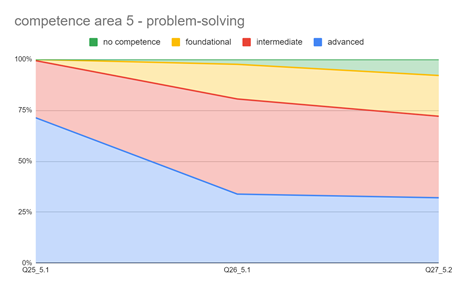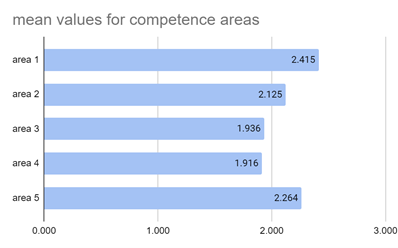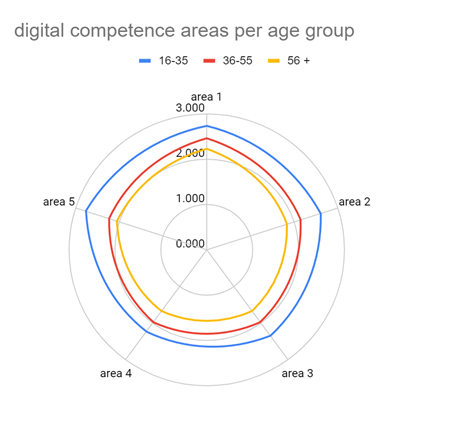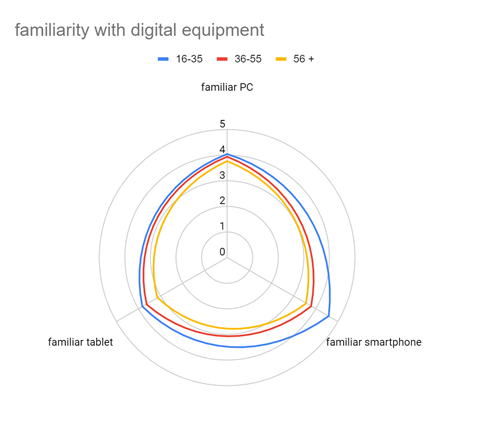COMPETENCE MAP
A map of the digital competencies of adults in Austria, Italy, and Greece.
AUGUST 2020
|
cover photo by Neil Moralee: https://www.flickr.com/photos/neilmoralee/ |
The Competence Map for DISK
To observe competence is a complex task. Competence includes the ability to perform, and a context to that performance. This makes observing competence, by setting up a meaningful context for it and observing it as it happens, or the outcomes of it, very challenging. Digital competence has been defined in different ways and understood as encompassing various areas of action and comprehension. In order to build this competence map, we followed the DigComp 2.1 – the European Digital Competence Framework for Citizens[1], its competence areas, and a selection of its proficiency levels. This reference framework allowed us to define a variety of competencies of importance to digital immigrants, i.e. to those who are living in an increasingly digital world in which they didn’t grow up, and to build an instrument dedicated to observing them.
Approach to the topic
Such direct observation of competence was not something possible to set up at this stage in the project, especially as we wanted to observe a large enough number of people – so we could get a nuanced map in terms of competencies. Thus, we opted to observe the perception of competence, listing 27 different actions, providing concrete examples of everyday tasks and actions involving digital competencies in one of the five areas included in the framework (list of the areas):
1 – information and data literacy;
2 – communication and collaboration;
3 – content creation;
4 – safety; and
5 – problem-solving.
For each of the 27 activities, participants responded, based on their experience, if they thought they could perform them, and if they were confident, they could perform them. We provided 4 possible answers, each representing a different proficiency level:
level 0 or no competence when people understood they could not do it at all;
level 1 or foundational level when respondents thought they could do it with support and/or guidance;
level 2 or intermediate level for the activities respondents consider they were able to do on their own, and a level 3 or advanced level for those activities participants understood they could explain to others and help them complete.
During the first trimester of 2020, we collected responses from 165 people from three different countries – Austria (N = 58), Italy (N = 74) and Greece (N = 33) – from different age groups (16 to 35 years old N = 30; 36 to 55 years old N = 70; and 56 or more N = 59).
Interactive Mindmap
We started by looking at each competence area in more detail. This allows us to consider how perceived competencies vary within them.
1. Competence Area Profiles
Regarding competence area 2: communication and collaboration (see Figure 2), participants find themselves more able to interact [2.1] and share different media [2.2] with others using digital technologies and digital identities [2.6]. Perceived competence drops for identifying authorship and copyright [2.5] and for digital forms of citizenship engagement [2.3].
Competence area 3: digital content creation (see Figure 3) has an overall higher percentage of people with no competence or foundational proficiency levels. The perceived competence is high for developing content [3.1] (e.g. using a computer for writing or a smartphone to take pictures) but much lower for integrating and re-elaborating it [3.2] or to understand and check copyright licenses and the uses they allow [3.3].
Competence area 4: safety (see Figure 4) is again one area where overall perceived competence is not as high. Results reflect the insecurity of several participants regarding their competence to, for example, evaluate the credibility of websites and apps and therefore protect their devices [4.1] or to keep their personal data safe and private [4.2] for example in the context of using online banking or filling online tax declarations.
Regarding competence area 5: problem-solving (see Figure 5) we focused on issues regarding solving some technical problems [5.1] involving, for example, making an equipment work again after it freezes and identifying technological responses to needs [5.2] such as installing and uninstalling software or apps. The proficiency levels are not always very high for these competencies which signals the need to foster problem-solving abilities with digital equipment.
Overall, we can also observe that participants report higher levels of competence in areas 1 – information and data literacy – which means they feel confident (means are higher than 2 indicating the ability to perform the task independently) about their ability to search, evaluate and manage data and information; and 5 – problem-solving – in terms of activities such as making equipment work, turning on and off, installing and uninstalling apps. Lower levels of competence were found for area 3 – digital content creation and area 4 – safety (means are lower than 2 indicating that participants feel they need support from others to perform the task). This highlights the importance of promoting competencies connected to understanding how to elaborate and integrate digital content, copyright information, or how to keep data safe and make sure they avoid scams and mistakes in tasks such as online banking or online tax declaration. A more detailed look at the competence area profiles is also informative regarding which competencies may be more in need of training.
Competence areas are highly and statistically significantly correlated with one another (all correlations are statistically significant and Pearson’s r values range between r = .703 and r = .810). Thus, people reporting higher levels of perceived competence in one area are very likely to report higher levels of perceived competence in other areas. They are also highly and statistically significantly correlated with the reported levels of familiarity with digital equipment such as the computer, the smartphone, or the tablet (all correlations are statistically significant and Pearson’s r values range between r = .432 and r = .596). This further supports our belief on the importance of creating contexts for familiarizing people with digital equipment while fostering competence in using them. We expect DISK modules to contribute to this.
2. Age groups and their different competence profiles
Older people are not necessarily people who did not have opportunities to engage with and master digital technologies – many of those who were very actively engaged in creating and developing them would fall into that age group – but for some, likely a majority of them, those opportunities were scant and came later in life making it harder for them to build the competencies necessary to use these technologies better and more confidently. They, as others who did not have these opportunities, are being forced to travel by the wave of digitalization to the world created.
Next, we will be looking at how differences between age groups can further inform us on what these educational contexts should focus on and what to keep in mind.
There is a visible gap in the perceived competence of people in different age groups. These differences are not only visible, but we also found them to be systematic – the differences between the groups are statistically significant in all cases except for the differences between age group 1 (aged 16-35) and age group 2 (aged 36-55) in competence area 4 and between age group 2 (aged 36-55) and age group 3 (aged 56 or more) in competence area 5 -, and often pronounced – calculated effect sizes were often high (Cohen’s d > 0.8), especially for the differences between age group 1 (aged 16-35) and age group 3 (aged 56 or more). It is also important to note that, as the scale represents the proficiency levels, for older groups competence area 3 – content creation -, competence area 4 – safety -, and also (even if to a lesser extent) competence area 2 – communication and collaboration – are areas where perceived competence is below 2, below intermediate proficiency level, which means that these adults are often unable to perceive themselves as competent in those areas to use digital technologies on their own.
Finally, one word about equipment. As the graph clearly shows us, familiarity with smartphones is lower among older age groups (those between 36 and 55 and those 56 or more). When compared to the younger group, they have systematically lower familiarity with smartphones (there is a statistically significant effect), and the effect is pronounced (Cohen’s d effect size indicator d > .80). Smartphones are one of the most recent digital technologies to take a prominent role in our everyday lives. In little, over ten years, smartphones became one ubiquitous object, central to our lives and to connecting us to the world. These results confirm the need to focus on providing older adults with content that helps adult and older adult users to confidently take advantage of this equipment in their lives.
Appendix
DISK Digital Competence Questionnaire
Response options:
a) I cannot do it at all;
b) I can do it with support and/or guidance;
c) I can do it on my own;
d) I can explain to others how to do it and help them
Items:
- I can search the web and find specific information like, for example, job offers. [1.1] 3
[3] The numbers between the square brackets refer to the digital competencies as defined in DigComp 2.1. - I can look for different platforms and websites and choose one that can give me results more adjusted to my needs (e.g. in terms of job offers or real estate listings, for example). [1.3]
- Use keywords or tags to get better search results (for example technical information, or job offers). [1.1]
- I can evaluate search sources and results in terms of their credibility and cross-check information when necessary. [1.2]
- I can find software, tools, or an app that helps me save and retrieve the information I’ve gathered or collected. (e.g. notes; bookmarks; etc.). [1.3]
- I can use a computer or a smartphone to manage everyday tasks and solve problems (e.g. calculate a sum, find an address, etc.) [1.6]
- I can interact with others, for work or leisure, using chat apps (e.g. WhatsApp, skype) or email. [2.1]
- I can choose between different smartphone apps or computer software to communicate and/or collaborate with others, for example in a group chat or a conference (video) call. [2.1]
- I know how to create a login and join a digital social network (e.g. Facebook, Twitter, Instagram, Pinterest)? [2.6]
- I can share different media (e.g. a photo or a text post) with others, for example on a digital social network, like Facebook or Twitter, using a computer or a smartphone. [2.2]
- I can identify authorship and copyright in various media (text, images, video, and audio). [2.5]
- I can use an app or website to create an event or a campaign (using for example groups or hashtags [#]) to call attention to or address a social or political issue. [2.3]
- I have a digital identity and I can use it to communicate to others or stay in contact with others. [2.6]
- I can engage and interact with others online (e.g. in social network sites like Facebook or in chat apps like Skype) in ways that protect my identity, myself, and others. [2.1]
- I can use a computer or a smartphone to express myself in writing or with pictures. a) I cannot do it at all; b) I can do it with support and/or guidance; c) I can do it on my own; d) I can explain to others how to do it and help them [3.1]
- I can edit or modify an image (e.g. crop, change the size, correct colors, or add text) and use it to present something to others. [3.2]
- I can edit or modify a video (e.g. trim, correct colors, or add text) and use it to present something to others. [3.2]
- I can check the copyright licenses of images, videos (or other content) and I understand the uses they allow. [3.3]
- I can take care of banking tasks online (check accounts, make transfers or payments, etc.). [4.2]
- I can take care of my taxes or social security issues online. [4.2]
- I can identify safety rules regarding passwords or other sensitive information (e.g. not sharing a password or credit card information). [4.1]
- I can keep information safe in digital platforms or in digital devices like computers or smartphones. [4.2]
- I can identify and use apps or software that can be used to support the safety and protection of information and devices (e.g anti-virus software). [4.2]
- I can evaluate the credibility of a site or an app and evaluate the risks it may bring [4.1]
- I can start, restart, and shut down my computer or my smartphone [5.1]
- I can make my computer or my smartphone work again if it freezes due to a simple problem. [5.1]
- I can install or uninstall computer software or smartphone apps to make my smartphone or my computer work as I need. [5.2]









